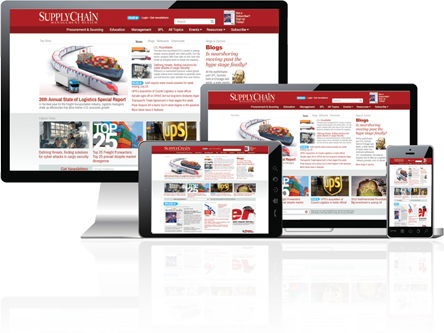The Fourth Industrial Revolution: Some Supply Chain Managers Just Don’t Get It
Whether you call it the Fourth Industrial Revolution or give it some other name, the source of competitive advantage is about to change, and your current strategy is most likely going to kill your business unless you prepare.


Latest News
Supply Chain Services acquires Dasco Label Automated storage and retrieval system (ASRS) market worth $10.7 billion by 2025 Trucking comeback: Dohrn Transfer turns the corner with assist from Pitt Ohio JSCM Video: Managing buyer-supplier conflicts JSCM Video: Managing buyer-supplier conflicts More NewsLatest Resource
Simplifying Your End-to-End Supply Chain Download this report highlighting each point on the supply chain journey by explaining the role it plays, which includes the pain points you may face, what you should be thinking about at a particular stage in the journey, and what technology you can benefit from.
Download this report highlighting each point on the supply chain journey by explaining the role it plays, which includes the pain points you may face, what you should be thinking about at a particular stage in the journey, and what technology you can benefit from.
All Resources
Evidence that most leaders don’t “get it” is the fact that the top 10% “superstar” companies accrue 80% of the economic value in their industries. Most supply chain leaders don’t really understand what’s so different about the changes underway thanks to technology, or are simply unable to afford the technology. Whether you call it the Fourth Industrial Revolution or give it some other name, the source of competitive advantage is about to change, and your current strategy is most likely going to kill your business unless you prepare.
Traditional supply chain strategy creates rigidity. Imagine your supply chain as a series of nodes where inventory comes to rest, either because it is stored or it is transformed or it is incorporated into a higher assembly. These nodes are connected by arcs that represent logistics or transportation. Traditional supply chain strategy prescribes lose relationships and supply base reduction, meaning that the arcs become fixed and unchanging. We use ERP and related IT to monitor the processes both within and between the nodes. And the monitoring is based on a few key performance metrics that seldom change. The benefits to these approaches are well-established. Nevertheless, a lot of conventional wisdom is about to be up-ended.
Imagine instead an entire eco-system of interconnected companies across the entire economy. There’s seamless information sharing, financial processing, and real-time monitoring that connects frontline customer interactions directly with production no matter how far away. All of this is abetted by algorithms and artificial intelligence that can shift the focus from key performance metrics to whatever metric matters the most for the individual worker or company at a given moment and under individual circumstances. This is also done in real time so that everyone knows right away that, let’s say, a truck broke down hours before the shipment fails to arrive, or that a customer five thousand miles away just had a new product arrive in a poorly functioning condition due to a design flaw.
In other words, the fixed arcs in our supply chain are no longer fixed. Supply chains will be able to come together, break apart, change, and adapt in real time. Flexible manufacturing will get a boost from 3D printing, and the end result will be an even greater divide between those companies who do and don’t “get” their customers and also have a deep awareness of supplier market capabilities. If you want a primitive glimpse of what the future might look like, check out what Alibaba is doing or the implications of 5G for industry.

About the Author
 Michael Gravier
Michael Gravier is a Professor of Marketing and Supply Chain Management at Bryant University with a focus on logistics, supply chain management and strategy and international trade. Follow Bryant University on Facebook and Twitter.
Michael Gravier
Michael Gravier is a Professor of Marketing and Supply Chain Management at Bryant University with a focus on logistics, supply chain management and strategy and international trade. Follow Bryant University on Facebook and Twitter.

Subscribe to Supply Chain Management Review Magazine!
Subscribe today. Don't Miss Out!Get in-depth coverage from industry experts with proven techniques for cutting supply chain costs and case studies in supply chain best practices.
Start Your Subscription Today!
 Simplifying Your End-to-End Supply Chain
Download this report highlighting each point on the supply chain journey by explaining the role it plays, which includes the pain points you may face, what you should be thinking about at a particular stage in the journey, and what technology you can benefit from.
Download Today!
Simplifying Your End-to-End Supply Chain
Download this report highlighting each point on the supply chain journey by explaining the role it plays, which includes the pain points you may face, what you should be thinking about at a particular stage in the journey, and what technology you can benefit from.
Download Today!
 When COVID-19 was bringing other supply chains to a screeching halt, AGCO acted early and decisively to keep its operations around the world up and running. The key: A very agile supply chain.
When COVID-19 was bringing other supply chains to a screeching halt, AGCO acted early and decisively to keep its operations around the world up and running. The key: A very agile supply chain.
Supply Chain Management is not enough Risk Management in an Era of Extreme Uncertainty View More From this Issue
 Master Your Supply Chain with an Intelligent Control Tower
Today’s control towers provide powerful capabilities and real-time responsiveness with Autonomous Problem-Solving, Global Demand-Supply Matching and Global Available-to-Promise.
Register Today!
Master Your Supply Chain with an Intelligent Control Tower
Today’s control towers provide powerful capabilities and real-time responsiveness with Autonomous Problem-Solving, Global Demand-Supply Matching and Global Available-to-Promise.
Register Today!











